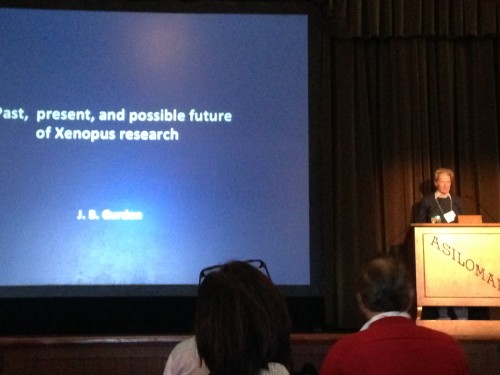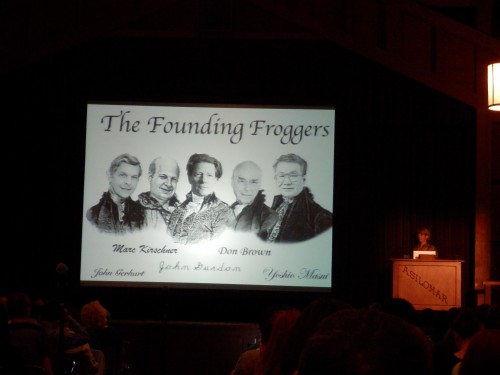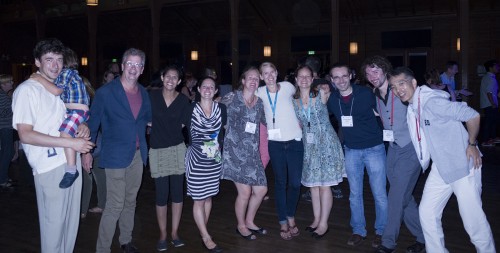I left my frog in San Francisco:
The 15th International Xenopus Conference
Asilomar CA, 2014
Posted by Gary McDowell, on 22 September 2014
Every two years, the international Xenopus community gathers to meet. Two years ago I wrote about the meeting in Toulon, France and this time we crossed the pond to Asilomar, CA, just south of San Francisco. Cat Vicente recently wrote about Asilomar in the context of conference venues whilst attending the Genetics Society of America Xenopus conference for the Node.
The conference gives a chance for researchers in various fields, but with the common model system of Xenopus, to discuss their work. The meeting this year took a new direction in not having themed sessions, but rather mixing talks from very different fields into each session. This had the dual purpose of keeping everyone’s attention by switching between different subjects rapidly, but also ensuring people were more likely to stay around for talks outside their field. There was also a strong focus on getting junior faculty and postdocs to speak rather than just the usual senior researchers that are well-known. For these reasons, I personally found this the most engaging conference I have been to.
Keynote talks
There were special lectures given by John Gurdon (Gurdon Institute, University of Cambridge) and Marc Kirschner (Department of Systems Biology, Harvard Medical School), both senior figures in the Xenopus community. John’s talk in particular gave an historical perspective on the beginnings of Xenopus as a model organism, including the transport of frogs from South Africa to the UK by Lancelot Hogben. Apparently, in the early days he was forced to keep his frog colony in the crypt of a church and managed to balance the books by charging hospitals to use frogs as pregnancy tests: when injected with the urine of pregnant women, the hormones present would induce the release of eggs from the female frogs. And from such humble beginnings, the research community has grown, with of course achievements such as John’s Nobel Prize. John speculated on the possible future for research in the frog and the aspiration to be able to track the behavior of individual proteins, within a cell, in real time.
John Gurdon’s special lecture: a historical perspective on the field of Xenopus research.
The keynote talk was given by Rebecca Heald of University of California, Berkeley. Rebecca’s lab focuses on questions to do with size and scaling of cells. In particular, looking at frogs there are basic questions about different species and different stages of development. Xenopus laevis eggs are nearly twice as big as Xenopus tropicalis and yet they are both single cells and, upon fertilization, undergo cleavage in the same way. How does this relate to the DNA content of the cells and how is this remarkable feat of engineering, in an cell so large, achieved? Also, as frog embryos develop, cells continuously divide whilst the embryo as a whole does not grow. What are the implications of maintaining a similar mechanism of cell division, starting in a cell as large as 1 mm in diameter and ending up at a fraction of the size? Work in frog egg and embryo extract is a significant part of the Xenopus field but not often universally used by frog researchers and it was an overview of some of the amazing work that can be achieved with the simple yet versatile extract system.
Rebecca Heald’s tribute to the “Founding Froggers”. Photo courtesy of Cat Vicente.
The community
The frog community also has numerous resources that we simply couldn’t do without: you can check out all things frog at Xenbase and there are three resource centres around the world: the National Xenopus Resource (NXR) in Wood’s Hole, MA; the European Xenopus Resource Centre (EXRC) at the University of Portsmouth, UK; and the National BioResource Project (NBRP) in Hiroshima, Japan which have stocks of wild type and transgenic frogs as well as components such as DNA clones and antibodies. All of these groups presented updates on work they are doing to support the community, such as the genome-editing workshop planned for November 2014 at Wood’s Hole.
Two special workshops were also arranged. One for trainee researchers looking for career advice both in academic and non-academic areas; and one for junior faculty looking for advice on getting tenure. I attended the PhD/postdoc session (as did the Node’s Cat Vicente – as a speaker for non-academic careers) and although the outlook is, as ever, sobering, it was still good to hear some advice specific to people who had worked on frog and some key things to keep in mind. Especially that it’s never too early to be thinking about the next step.
These are both key examples of why I’ve enjoyed my scientific training in the Xenopus community. I started off after finishing my Master’s in Chemistry and moved into a frog lab, and have worked in 3 frog labs/projects since. The sense of community and support provided by the Xenopus field is really quite unique and many who have passed through frog meetings have commented on this. There are some key figures driving the support of more junior faculty and trainees, which is sadly not the norm across all fields of academia.
Looking forward
Work in the model organism Xenopus seems to be really taking off because of all the different techniques that are available to frog researchers. Genetics and genome editing, with TALENs and the CRISP/Cas system, have expanded recently, particularly using the diploid genome of Xenopus tropicalis, but even the pseudoallotetraploid genome of Xenopus laevis, for so long considered a disadvantage, is by its nature of being so unique and outbred generating a lot of questions that other inbred model systems simply can’t answer. The use of Xenopus extracts for in vitro biochemical work was showcased in particular by Rebecca Heald’s lab and the questions that can be answered by the cell-in-a-test-tube system that Xenopus provides still leaves many frog researchers surprised. The rapid development and easy manipulation of frog embryos also allows many simple but elegant in vivo experiments. So, in reality, frogs can be used to answer a whole lot of questions rapidly (and cheaply). I will try to expand upon some of these themes in the near future; needless to say I don’t have time here except to mention what an adaptable model system is across many fields, from bioengineering to biochemistry to biophysics.
Frog friends! Photo courtesy of Atsushi Suzuki, from the National BioResource Project, Japan.
This was my third Xenopus conference; each time I’m unsure if I’ll be at the next one, so I always make sure to enjoy the company of my froggy friends; we always make sure to have a good time!
If you want to keep up with frog-related updates, you can follow various twitter accounts for Xenbase @Xenbase, the National Xenopus Resource at the Marine Biological Laboratory at Wood’s Hole @XenopusNXR and I also blog at bewareofthefrog.tumblr.com and @BiophysicalFrog.





 (7 votes)
(7 votes)